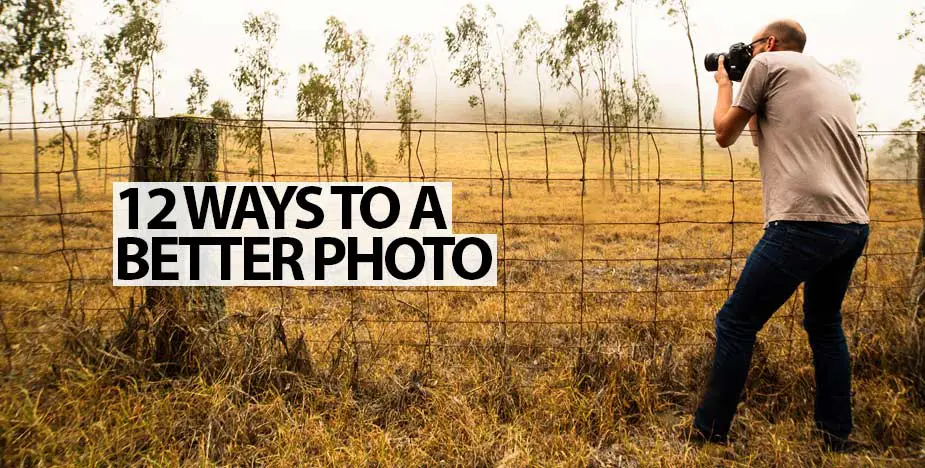Three years in the Advertising business, and 16 in photography, have convinced me that ideas are really powerful and that a photograph that has a strong idea is the most powerful tool to convey a message.
A strong idea is always brought out in a simple, clear picture that has a strong subject and minimal interference from unnecessary elements. The challenge is to do this in an easily repeatable manner so that you are able to consistently produce images that are at a level that surpass the average.
Everyone’s seen pictures where things have gone wrong… Images with bleached-out faces, heads cut off, tilting horizons, and telephone poles sticking out of heads! This kind of photography faux pas interferes with our understanding of what is happening in the photograph itself.
How Does One Consistently Produce Good Pictures?
There are some simple guiding principles that will serve you well on a day-to-day basis. No matter whether you’re taking photographs with a mobile phone, or taking photographs for an advertising campaign, these general principles will consistently give you results that will work.
1. Take Photos With the Sun Behind You!
No, don’t blind your family or friends, with the sun directly in their faces! In fact, doing that may make their faces lose their shape, giving them a flat appearance.
Keep the sun at an angle behind you and it will cast pleasing shadows, making the shape of their faces more apparent while still lighting them sufficiently. I’ve found that it is best to keep it between 30-70 degrees from the person. This doesn’t only have to apply to the sun, but to any main source of light in an image.
This tip works especially well if you are taking snapshots with a mobile phone or a point-and-shoot camera.
2. Use ‘Depth of Field’.
Though it sounds all complicated, depth of field is simply the area of a photograph that is in focus.
Try to get the background out of focus if it’s cluttering up the photograph. You can do this by moving in close, using a large aperture, and zooming in close. A lens with a long focal length and a wide aperture are favorites for this reason among portrait photographers.
The soft out-of-focus area is called bokeh, and the circles that are produced around points of light are called circles of confusion.
3. Fill Your Frame With the Subject.
One of the easiest mistakes to make is to have too much open space in an image. While the human eye can ‘zoom in’ to see an image, the camera has a fixed frame of reference, and sometimes we realize that the subject is too small only after the image is captured… What’s happened? Our mind has zoomed in on the small detail in the frame, not realizing that its proportion in relation to the borders of the photograph is too small.
Filling the frame with your subject will make your photograph clearer in intent, more defined, and easier to appreciate.
If your subject is both a monument as well as a person, make sure that the height of the person is at least one-third that of the viewfinder frame. This makes sure that people won’t have to squint to figure out who it is that’s in the picture.
4. Try Unusual Viewpoints
Try looking down from up, or up from down… sideways, and around corners! You never know how a different viewpoint could change the entire look of your photograph. Look for unusual shapes, colors, or textures. All of these elements make photographs memorable and distinct.
5. Look At the Background
Always be aware of what is in the background of your subject. All too often, we take a beautiful portrait of a loved one only to find that a street lamp is sticking out from behind their head in the image.
Simplify the background. A cluttered background will always interfere with the photograph. Try to un-clutter with simple, textured walls, patterned windowpanes, or anything that is striking, yet non-intrusive.
Remember that the lamp post sticking out of your mother-in-law’s head isn’t funny to anyone except you! Don’t do it…
6. Really Look At The Picture That You’re Taking
While you’re taking your photograph, analyze it for a moment before taking the photograph. Look for obvious issues that you know have happened in the past… Is anyone’s foot chopped off? If so adjust your framing… Can you get a better photograph by moving 5 feet to the right, or turning 30 degrees, to get better light? Do that… A little thoughtfulness can often be the difference between a mediocre or bad photograph, and one that is memorable.
Remember that elements in a photograph interact with each other because there is no real sense of ‘depth’ in the photograph. Also remember that your camera’s frame is also an element in itself, and unlike something that you see with your eyes, a photograph has a defined border.
So, place these elements in relation to each other as well as in relation to your camera’s frame. Don’t let important elements be cut off, or interfering elements intrude into your photographs.
7. Use the Rules of Composition When Possible
This is similar to the previous point. Composition in photography means – how different elements in a photograph are arranged in relation to each other, and how the frame of your photograph is placed overall.
These are “rules of thumb” that can be broken if you want. The rule of thirds, golden section, and usage of perspective, line, rhythm, and texture among others, can greatly improve the ‘viewability’ of your pictures.
8. Frame Your Subject Within a Shape
Doors, windows, walls, and hangings are good ways to emphasize the shape and size of the person that you’re photographing. Sometimes photographers take photographs framed within ‘created frames’ such as a person’s legs, to add depth. These can add interest, and at the same time simplify an image, creating strong shapes and patterns in your images.
9. On Vacation, Take Different Types of Pictures
Variety both in subject and style. Take some portraits of the locals, some close-ups of curios with interesting backgrounds, take some landscapes of the hills or the beaches. Take pictures of locals, restaurants that you liked, and things that you did. This gives you more to look at than just people’s faces, and adds dimension to your memories when you look at the pictures years later.
10. Remember That Your Brain Sees Things Differently
Your eyes see things, of course, but it’s the brain that interprets what you see. You may see a speck in the distance but its movement gives you a cue that it’s a car. Those cues are absent in a photograph.
Your brain has the ability to concentrate on just one object in a scene, like a pair of binoculars! It can zoom in on a detail even though the eyes take in a wide field of view. All too often we look at pictures in which we see just a bare beach or just hills when in fact we were trying to capture the strange bird on the beach or the cute house nestled among the trees below the hill.
Remember that as a guide, an object needs to fill up at least 1/5th of the camera’s frame to be clearly visible.
11. Keep Taking Photos
By this I mean take pictures with regularity Taking photos every week is a good benchmark to aim for.
After all, practice makes you better, and you need to keep getting better, to start producing good pictures.
Imagine trying to win a table tennis match after practicing once a year! It’s the same case with photography.
Here’s a great exercise:
Choose a household object and take a single photograph of it every day for five days. Try to make each photograph as distinct from the others as possible. This will keep you in touch with your camera and hone your compositional, and creative skills to a great degree.
12. Read Your Camera’s User Manual
Learn how to use the different modes of your camera and flash. Your camera’s user manual can be quite handy for that.
In it, you’ll learn how fill-flash can help you when you’re taking pictures in the sun and how “red-eye-reduction” can help reduce the “deer in the headlights” feel that you sometimes get.
Believe me, I’m not trying to turn you into a bookworm! Each camera is laid out a little differently, and it would be pointless trying to give directions for every camera, but these are standard features, so you’ll pick up the options on a new camera quite easily and quickly.
Summing It All Up
Taking photographs is always a learning experience. Even the most experienced photographer learns every time that they take photos. So be aware of all the points that we have shared, and always remember that it’s not your camera that takes the photograph. It’s you!
Like veteran wildlife photographer T.N.A. Perumal said in an interview with the daily newspaper The Hindu, “No matter how good the camera, and how many more frames you can click per second, it is instant visualization, legwork and immense patience that produces that masterpiece.”
So go ahead! Make that masterpiece! And share with us in the comments below!
Help Us To Continue Creating
Get our email newsletter to stay up-to-date with our latest posts. It’s easy to read and is mailed once in 2 weeks.
The easiest way to support Beyond Photo Tips is by using our affiliate links when you buy anything at all. It will never cost you anything extra, and we get a small commission from it, which helps us a LOT! We share our recommended equipment list here.
Some of the links to products on this website are affiliate links, and we only ever link out to gear that we recommend.
You could also show your appreciation by buying us a coffee. Finally, we appreciate you being a part of the community, so do say hi!





